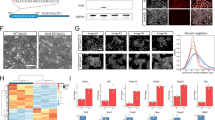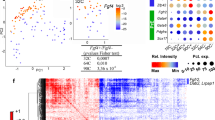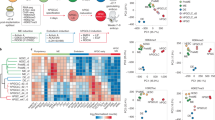Abstract
Nanog is a divergent homeodomain protein found in mammalian pluripotent cells and developing germ cells1,2. Deletion of Nanog causes early embryonic lethality2, whereas constitutive expression enables autonomous self-renewal of embryonic stem cells1. Nanog is accordingly considered a core element of the pluripotent transcriptional network3,4,5,6,7. However, here we report that Nanog fluctuates in mouse embryonic stem cells. Transient downregulation of Nanog appears to predispose cells towards differentiation but does not mark commitment. By genetic deletion we show that, although they are prone to differentiate, embryonic stem cells can self-renew indefinitely in the permanent absence of Nanog. Expanded Nanog null cells colonize embryonic germ layers and exhibit multilineage differentiation both in fetal and adult chimaeras. Although they are also recruited to the germ line, primordial germ cells lacking Nanog fail to mature on reaching the genital ridge. This defect is rescued by repair of the mutant allele. Thus Nanog is dispensible for expression of somatic pluripotency but is specifically required for formation of germ cells. Nanog therefore acts primarily in construction of inner cell mass and germ cell states rather than in the housekeeping machinery of pluripotency. We surmise that Nanog stabilizes embryonic stem cells in culture by resisting or reversing alternative gene expression states.
This is a preview of subscription content, access via your institution
Access options
Subscribe to this journal
Receive 51 print issues and online access
$199.00 per year
only $3.90 per issue
Buy this article
- Purchase on Springer Link
- Instant access to full article PDF
Prices may be subject to local taxes which are calculated during checkout




Similar content being viewed by others
References
Chambers, I. et al. Functional expression cloning of Nanog, a pluripotency sustaining factor in embryonic stem cells. Cell 113, 643–655 (2003)
Mitsui, K. et al. The homeoprotein Nanog is required for maintenance of pluripotency in mouse epiblast and ES cells. Cell 113, 631–642 (2003)
Boyer, L. A. et al. Core transcriptional regulatory circuitry in human embryonic stem cells. Cell 122, 947–956 (2005)
Loh, Y. H. et al. The Oct4 and Nanog transcription network regulates pluripotency in mouse embryonic stem cells. Nature Genet. 38, 431–440 (2006)
Wang, J. et al. A protein interaction network for pluripotency of embryonic stem cells. Nature 444, 364–368 (2006)
Chickarmane, V., Troein, C., Nuber, U. A., Sauro, H. M. & Peterson, C. Transcriptional dynamics of the embryonic stem cell switch. PLoS Comput. Biol. 2, e123 (2006)
Ivanova, N. et al. Dissecting self-renewal in stem cells with RNA interference. Nature 442, 533–538 (2006)
Ying, Q. L., Nichols, J., Chambers, I. & Smith, A. BMP induction of Id proteins suppresses differentiation and sustains embryonic stem cell self-renewal in collaboration with STAT3. Cell 115, 281–292 (2003)
Hatano, S. Y. et al. Pluripotential competence of cells associated with Nanog activity. Mech. Dev. 122, 67–79 (2005)
Vallier, L. et al. An efficient system for conditional gene expression in embryonic stem cells and in their in vitro and in vivo differentiated derivatives. Proc. Natl Acad. Sci. USA 98, 2467–2472 (2001)
Robertson, M. et al. Nanog retrotransposed genes with functionally conserved open reading frames. Mamm. Genome 17, 732–743 (2006)
Brons, I. G. et al. Derivation of pluripotent epiblast stem cells from mammalian embryos. Nature 448, 191–195 (2007)
Tesar, P. J. et al. New cell lines from mouse epiblast share defining features with human embryonic stem cells. Nature 448, 196–199 (2007)
Niwa, H. How is pluripotency determined and maintained? Development 134, 635–646 (2007)
Chambers, I. & Smith, A. Self-renewal of teratocarcinoma and embryonic stem cells. Oncogene 23, 7150–7160 (2004)
Lowell, S., Benchoua, A., Heavey, B. & Smith, A. G. Notch promotes neural lineage entry by pluripotent embryonic stem cells. PLoS Biol. 4, e121 (2006)
Ying, Q. L., Stavridis, M., Griffiths, D., Li, M. & Smith, A. Conversion of embryonic stem cells into neuroectodermal precursors in adherent monoculture. Nature Biotechnol. 21, 183–186 (2003)
Yamaguchi, S., Kimura, H., Tada, M., Nakatsuji, N. & Tada, T. Nanog expression in mouse germ cell development. Gene Expr. Patterns 5, 639–646 (2005)
Scholer, H. R., Dressler, G. R., Balling, R., Rohdewohld, H. & Gruss, P. Oct-4: a germline-specific transcription factor mapping to the mouse t-complex. EMBO J. 9, 2185–2195 (1990)
Toyooka, Y. et al. Expression and intracellular localization of mouse Vasa-homologue protein during germ cell development. Mech. Dev. 93, 139–149 (2000)
Szabo, P. E., Hubner, K., Scholer, H. & Mann, J. R. Allele-specific expression of imprinted genes in mouse migratory primordial germ cells. Mech. Dev. 115, 157–160 (2002)
Hajkova, P. et al. Epigenetic reprogramming in mouse primordial germ cells. Mech. Dev. 117, 15–23 (2002)
Monk, M. & McLaren, A. X-chromosome activity in foetal germ cells of the mouse. J. Embryol. Exp. Morphol. 63, 75–84 (1981)
Shi, W. et al. Regulation of the pluripotency marker Rex-1 by Nanog and Sox2. J. Biol. Chem. 281, 23319–23325 (2006)
Suzuki, A. et al. Maintenance of embryonic stem cell pluripotency by Nanog-mediated reversal of mesoderm specification. Nature Clin. Pract. Cardiovasc. Med. 3 (suppl. 1). S114–S122 (2006)
Hart, A. H., Hartley, L., Ibrahim, M. & Robb, L. Identification, cloning and expression analysis of the pluripotency promoting Nanog genes in mouse and human. Dev. Dyn. 230, 187–198 (2004)
Silva, J., Chambers, I., Pollard, S. & Smith, A. Nanog promotes transfer of pluripotency after cell fusion. Nature 441, 997–1001 (2006)
Smith, A. G. Culture and differentiation of embryonic stem cells. J. Tissue Cult. Methods 13, 89–94 (1991)
Ashfield, R. et al. MAZ-dependent termination between closely spaced human complement genes. EMBO J. 13, 5656–5667 (1994)
Schwartzberg, P. L., Goff, S. P. & Robertson, E. J. Germ-line transmission of a c-abl mutation produced by targeted gene disruption in ES cells. Science 246, 799–803 (1989)
Nagy, A., Gertsenstein, M., Vintersten, K. & Behringer, R. Manipulating the Mouse Embryo: A Laboratory Manual (Cold Spring Harbor Press, New York, 2003)
Chambers, I. Mechanisms and factors in embryonic stem cell self-renewal. Rend. Fis. Acc. Lincei s.9, v.16. 83–97 (2004)
Lowell, S., Benchoua, A., Heavey, B. & Smith, A. G. Notch promotes neural lineage entry by pluripotent embryonic stem cells. PLoS Biol. 4, e121 (2006)
Laemmli, U. K. Cleavage of structural proteins during the assembly of the head of bacteriophage T4. Nature 227, 680–685 (1970)
Acknowledgements
We are grateful to V. Karwacki, A. Waterhouse, R. Wilkie, R. MacLay and J. Ure for technical assistance, to C. Manson, J. Verth and colleagues for animal husbandry, and to V. Wilson for comments on the manuscript. This research was supported by the Wellcome Trust, the Juvenile Diabetes Research Foundation, the Medical Research Council and the Biotechnological and Biological Sciences Research Council of the United Kingdom, and a Human Frontier Science Program Fellowship (to L.G.).
Author Contributions I.C. designed the experimental strategy and analysed the data; J.S., J.N. and A.S. contributed to the experimental design. J.S., J.N. and K.J. performed the chimaera study, and J.S. the confocal analyses. D.C. conducted gene targeting and cell biological analysis, and together with J.V. ran the FACS experiments. M.R. and B.N. performed molecular biological analyses. L.G. produced and characterized the ROSA26-Cre-ERT2 cells. I.C. and A.S. conceived the study and wrote the paper.
Author information
Authors and Affiliations
Corresponding author
Supplementary information
Supplementary Information
The file contains Supplementary Tables 1-4 and Supplementary Figures 1-12 (PDF 4603 kb)
Supplementary Video 1
This file contains Supplementary Video 1 showing bright field of GFP- TNG cells from 24-44h post-plating (MOV 32601 kb)
Supplementary Video 2
This file contains Supplementary Video 2 showing fluorescent field of GFP TNG cells from 24-44h post-plating (MOV 42173 kb)
Rights and permissions
About this article
Cite this article
Chambers, I., Silva, J., Colby, D. et al. Nanog safeguards pluripotency and mediates germline development. Nature 450, 1230–1234 (2007). https://doi.org/10.1038/nature06403
Received:
Accepted:
Issue Date:
DOI: https://doi.org/10.1038/nature06403
This article is cited by
-
A computational model of stem cells’ internal mechanism to recapitulate spatial patterning and maintain the self-organized pattern in the homeostasis state
Scientific Reports (2024)
-
Monolayer platform to generate and purify primordial germ-like cells in vitro provides insights into human germline specification
Nature Communications (2023)
-
Molecular versatility during pluripotency progression
Nature Communications (2023)
-
Generation of pulsatile ERK activity in mouse embryonic stem cells is regulated by Raf activity
Scientific Reports (2023)
-
CasTuner is a degron and CRISPR/Cas-based toolkit for analog tuning of endogenous gene expression
Nature Communications (2023)
Comments
By submitting a comment you agree to abide by our Terms and Community Guidelines. If you find something abusive or that does not comply with our terms or guidelines please flag it as inappropriate.



